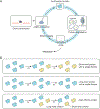The cochlea is built to last a lifetime
- PMID: 37295280
- PMCID: PMC10405781
- DOI: 10.1016/j.heares.2023.108821
The cochlea is built to last a lifetime
Abstract
Orchestration of protein production and degradation and the regulation of protein lifetimes play a central role in many basic biological processes. Nearly all mammalian proteins are replenished by protein turnover in waves of synthesis and degradation. Protein lifetimes in vivo are typically measured in days, but a small number of extremely long-lived proteins (ELLPs) persist for months or even years. ELLPs are rare in all tissues but are enriched in tissues containing terminally differentiated post-mitotic cells and extracellular matrix. Consistently, emerging evidence suggests that the cochlea may be particularly enriched in ELLPs. Damage to ELLPs in specialized cell types, such as crystallin in the lens cells of the eye, causes organ failure such as cataracts. Similarly, damage to cochlear ELLPs is likely to occur with many insults, including acoustic overstimulation, drugs, anoxia, and antibiotics, and may play an underappreciated role in hearing loss. Furthermore, hampered protein degradation may contribute to acquired hearing loss. In this review, I highlight our knowledge of the lifetimes of cochlear proteins with an emphasis on ELLPs and the potential contribution that impaired cochlear protein degradation has on acquired hearing loss and the emerging relevance of ELLPs.
Keywords: Autophagy; Long-lived proteins; Lysosome; Noise induced hearing loss; Post-mitotic cells; Proteasome; Protein degradation; Proteostasis; Ubiquitin.
Copyright © 2023. Published by Elsevier B.V.
Conflict of interest statement
Declaration of Competing Interest None.
Figures


Similar articles
-
Effects of lifetime noise exposure on the middle-age human auditory brainstem response, tinnitus and speech-in-noise intelligibility.Hear Res. 2018 Aug;365:36-48. doi: 10.1016/j.heares.2018.06.003. Epub 2018 Jun 12. Hear Res. 2018. PMID: 29913342
-
New insights on repeated acoustic injury: Augmentation of cochlear susceptibility and inflammatory reaction resultant of prior acoustic injury.Hear Res. 2020 Aug;393:107996. doi: 10.1016/j.heares.2020.107996. Epub 2020 May 18. Hear Res. 2020. PMID: 32534268 Free PMC article.
-
Loss of CX3CR1 augments neutrophil infiltration into cochlear tissues after acoustic overstimulation.J Neurosci Res. 2021 Nov;99(11):2999-3020. doi: 10.1002/jnr.24925. Epub 2021 Sep 14. J Neurosci Res. 2021. PMID: 34520571
-
Cochlear Preconditioning as a Modulator of Susceptibility to Hearing Loss.Antioxid Redox Signal. 2022 Jun;36(16-18):1215-1228. doi: 10.1089/ars.2021.0055. Epub 2021 Jun 29. Antioxid Redox Signal. 2022. PMID: 34011160 Review.
-
Cellular signaling protective against noise-induced hearing loss – A role for novel intrinsic cochlear signaling involving corticotropin-releasing factor?Biochem Pharmacol. 2015 Sep 1;97(1):1-15. doi: 10.1016/j.bcp.2015.06.011. Epub 2015 Jun 11. Biochem Pharmacol. 2015. PMID: 26074267 Free PMC article. Review.
Cited by
-
The Relevance of Autophagy within Inner Ear in Baseline Conditions and Tinnitus-Related Syndromes.Int J Mol Sci. 2023 Nov 23;24(23):16664. doi: 10.3390/ijms242316664. Int J Mol Sci. 2023. PMID: 38068993 Free PMC article. Review.
-
A deafness-blindness syndrome results from ATF6-based disruption of the unfolded protein response.J Clin Invest. 2025 Feb 3;135(3):e188708. doi: 10.1172/JCI188708. J Clin Invest. 2025. PMID: 39895634 Free PMC article.
-
Health position paper and redox perspectives - Disease burden by transportation noise.Redox Biol. 2024 Feb;69:102995. doi: 10.1016/j.redox.2023.102995. Epub 2023 Dec 18. Redox Biol. 2024. PMID: 38142584 Free PMC article. Review.
References
-
- Adler HJ. 1996. Tectorial membrane repair in the quail following multiple exposures to intense sound. Audiol Neurootol 1: 65–79 - PubMed
-
- Anoop P, Patil CN, Joshi VS, Maurya P, Hosamani P. 2016. Sensorineural deafness: An uncommon irreversible adverse effect of bortezomib. Indian J Cancer 53: 459. - PubMed
-
- Bada JL. 1984. In vivo racemization in mammalian proteins. Methods Enzymol 106: 98–115 - PubMed
Publication types
MeSH terms
Grants and funding
LinkOut - more resources
Full Text Sources
Medical

